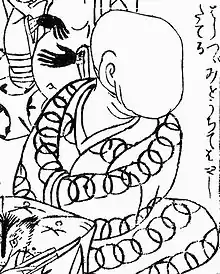Noppera-bō
The Noppera-bō (のっぺらぼう), or faceless ghost, is a Japanese yōkai that looks like a human but has no face. They are sometimes mistakenly referred to as a mujina, an old Japanese word for a badger or raccoon dog.[1] Although the mujina can assume the form of the other, noppera-bō are usually disguised as humans. Such creatures were thought to sometimes transform themselves into noppera-bō in order to frighten humans. Lafcadio Hearn used the animals' name as the title of his story about faceless monsters, probably resulting in the misused terminology.

Noppera-bō are known primarily for frightening humans, but are usually otherwise harmless. They appear at first as ordinary human beings, sometimes impersonating someone familiar to the victim, before causing their features to disappear, leaving a blank, smooth sheet of skin where their face should be.
In legends
Often, a noppera-bō would not actually exist, but was the disguise of a mujina, a fox kitsune, or a tanuki.[2] In Showa 4 (1767), in the kaidan collection Shinsetsu Hyakumonogatari, there were stories that told of how in Nijugawara in Kyoto (near the Nijo-ohashi bridge in the Nakagyō-ku, Kyoto), a monster called noppera-bō appeared and those that were attacked by it would have several thick hairs attached to their clothing, indicating that it was the disguise of some kind of animal.[3] However, sometimes their real identity is not known, and in the Kanbun 3 (1663) kaidan collection Sorori Monogatari, it was written that in the Oike-cho of the capital (now Nakagyō-ku, Kyoto), there appeared a noppera-bō with a height of about 7 shaku (about 2.1 meters), but nothing was written about what its true identity was.[4] They are also said to appear in folktales in the Osaka Prefecture[5] and Kotonami, Nakatado District, Kagawa Prefecture among other places.[6]
The Noppera-bō and the Koi Pond
This tale recounts a lazy fisherman who decided to fish in the imperial koi ponds near the Heian-kyō palace. Despite being warned by his wife about the pond being sacred and near a graveyard, the fisherman went anyway. On his way to the pond, he is warned by another fisherman not to go there, but he again ignores the warning. Once at the spot, he is met by a beautiful young woman who pleads with him not to fish in the pond. He ignores her and, to his horror, she wipes off her face. Rushing home to hide, he is confronted by what seems to be his wife, who chastises him for his wickedness before wiping off her facial features as well.
The Mujina of the Akasaka Road
The most famous story recollection of the Noppera-bō comes from Lafcadio Hearn's book Kwaidan: Stories and Studies of Strange Things titled Mujina. The story of a man who travelled along the Akasaka road to Edo, he came across a young woman in a remote location near Kunizaka hill, crying and forlorn. After attempting to console the young woman and offer assistance, she turned to face him, startling him with the blank countenance of a faceless ghost. Frightened, the man proceeded down the road for some time, until he came across a soba vendor. Stopping to relax, the man told the vendor of his tale, only to recoil in horror as the soba vendor stroked his face, becoming a noppera-bō himself. It turns out that all of these noppera-bō were really just mujina in disguise.
There are other tales about noppera-bō, from a young woman rescued from bandits by a samurai on horseback whose face disappears; to stories of nobles heading out for a tryst with another, only to discover the courtesan is being impersonated by a noppera-bō.
Recent reports
Although most tales of noppera-bō predate the 20th century, there are exceptions, both in Japan itself as well as locations where Japanese have emigrated, most notably the U.S. state of Hawaii. Among the most recent reports:
- On May 19, 1959, Honolulu Advertiser reporter Bob Krauss reported a sighting of a mujina at the Waialae Drive-In Theatre in Kahala. Krauss reported that the witness watched a woman combing her hair in the women's restroom, and when the witness came close enough, the mujina turned, revealing her featureless face. The witness was reported to have been admitted to the hospital for a nervous breakdown. Noted Hawaiian historian, folklorist, and author Glen Grant, in a 1981 radio interview dismissed the story as rumor, only to be called by someone claiming to be the witness, who gave more details on the event, including the previously unreported detail that the mujina in question had red hair.[7]
- Grant has also reported on a number of other mujina sightings in Hawaii, from Ewa Beach to Hilo.
See also
- Kuchisake-onna ("Slit Mouth Woman"), a Japanese urban legend about a disfigured woman
- Slender Man, a fictional supernatural character with no facial features
- Spirited Away, a 2001 Japanese animated film featuring a character known as "No-Face"
References
- Spettoli, Letizia (2017-07-03). "Mujina: la leggenda giapponese dello spirito senza volto". Notizie.it (in Italian). Archived from the original on 2017-07-08. Retrieved 2020-09-06.
- 村上健司編著 (2005). 日本妖怪大事典 [Japanese Youkai Encyclopedia]. Kwai books. 角川書店. pp. 255頁. ISBN 978-4-04-883926-6.
- 高古堂小幡宗佐衛門 (1993). "新説百物語". In 太刀川清校訂 (ed.). 続百物語怪談集成 [A collection of ghost stories]. 国書刊行会. pp. 216頁. ISBN 978-4-336-03527-1.
- 編著者不詳 (1989). "曾呂利物語". In 高田衛編・校注 (ed.). 江戸怪談集 [Edo Kaidan Collection]. 岩波文庫. 中. 岩波書店. pp. 63–65頁. ISBN 978-4-00-302572-7.
- 山川隆平. "民間伝承 26巻2号 船場怪談" [Folklore Vol. 26, No. 2 Senba Kaidan]. 怪異・妖怪伝承データベース. 国際日本文化研究センター. Retrieved 21 August 2010.
- 北條令子 (August 1985). "海と山の妖怪話" [Sea and mountain youkai story]. 香川の民俗. 香川民俗学会 (通巻44号): 7頁.
- "The Faceless Woman". Archived from the original on October 23, 2009. Retrieved 2008-10-01.
External links
- Noppera-bo (No Face) at ScaryForKids
- Entry on "nopperabou" at The Obakemono Project
- Lafcadio Hearn's story at Monogatari.org
- Pierre Wayser's flash video of the mujina story (in French)
- webpage regarding the 1959 and 1981 reports of the Waialae Mujina
- Discussion of the confusion of terms brought about by the titles of Hearn's stories.

